Gospels and Acts, 16 vols. (Library of New Testament Studies | LNTS)
Digital Logos Edition
Overview
These Library of New Testament Studies volumes on the Gospels and Acts collection provides timely and engaging investigations of issues concerning the Gospels and Acts. These 16 academic volumes contest some long-held arguments and buttress others, but do so through the latest Biblical scholarship and methodology. Topics include the case for an earlier composition of Mark, the intertextual connections to Ezekiel in John and Second Temple literature, the Lukan understanding of the Holy Spirit, the Jewish context for Jesus’ miracles, and many others.

The Journal for the Study of the New Testament Supplement (renamed the Library of New Testament Studies in 2005) is a premier book series that offers cutting-edge work for a readership of scholars, teachers in the field of New Testament studies, postgraduate students and advanced undergraduates. The series was launched by Sheffield Academic Press in 1981 to complement its associated journal, the Journal for the Study of the New Testament. All the many and diverse aspects of New Testament study are represented and promoted in the series, including innovative work from historical perspectives, studies using social-scientific and literary theory, and developing theological, cultural and contextual approaches.
- Title: Library of NT Studies: JSNTS on the Gospels and Acts (16 vols.)
- Publisher: T & T Clark
- Volumes: 16
- Pages: 4,750
- Resource ID: {CE56E534-6519-42DC-AB5C-02E0255BBB64}
This title is included in the following collections
You can save when you purchase this product as part of a collection.
Library of New Testament Studi...
$2,341.15$1,637.99Logos 8 Lutheran Diamond Legac...
$2,999.99$2,999.99Logos 9 Lutheran Diamond Legac...
$2,999.99$2,999.99Library of New Testament Studi...
$4,843.30$3,499.99
- $4,899.99$4,164.99
- $4,749.99
- $4,749.99
- $4,749.99
- $4,749.99
- $4,749.99
- $4,749.99
- $4,749.99
- $4,749.99
- $7,749.99
- $11,399.99
- $21,749.99
- $23,999.99
- $24,999.99
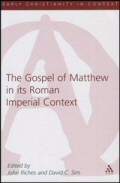
This collection of scholarly essays tackles a number of questions based on Matthew’s gospel. In what sense does Matthew's Gospel reflect the colonial situation in which the community found itself after the fall of Jerusalem and the subsequent humiliation of Jews across the Roman Empire? To what extent was Matthew seeking to oppose Rome's claims to authority and sovereignty over the whole world, to set up alternative systems of power and society, to forge new senses of identity? If Matthew's community felt itself to be living on the margins of society, where did it see the centre as lying? In Judaism or in Rome? And how did Matthew's approach to such problems compare with that of Jews who were not followers of Jesus Christ and with that of others, Jews and Gentiles, who were followers?
John K. Riches is Professor of Divinity and Biblical Criticism Emeritus, University of Glasgow.
Dr. David Sim is Senior Lecturer in Theology, Australian Catholic University, Queensland.
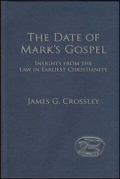
This book argues that Mark’s gospel was not written as late as c. 65–75 CE, but dates from sometime between the late 30s and early 40s CE. It challenges the use of the external evidence (such as Irenaeus and Clement of Alexandria) often used for dating Mark, relying instead on internal evidence from the gospel itself. James Crossley also questions the view that Mark 13 reflects the Jewish war, arguing that there are other plausible historical settings.
Crossley argues that Mark’s gospel takes for granted that Jesus fully observed biblical law and that Mark could only make such an assumption at a time when Christianity was largely law observant: and this could not have been later than the mid-40s, from which point on certain Jewish and gentile Christians were no longer observing some biblical laws (e.g. food, Sabbath).
Dr. James G. Crossley is tutor at the Centre for Jewish-Christian Relations and the Institute of Continuing Education at the University of Cambridge.
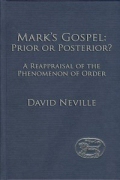
The similarities and differences of arrangement and order of episodes in the gospels of Mark, Matthew and Luke have always been one of the major criteria for resolving the Synoptic Problem. How important and how reliable are arguments based on such considerations, and where might they lead?
Here, Neville reviews these issues in detail, explaining the significance of his conclusions for understanding the literary relationships among the three Synoptic gospels, and particularly for the competing theories of Markan priority (the standard two-source hypothesis) and Markan posteriority (the Griesbach hypothesis).
David Neville lectures in New Testament studies at St Mark’s National Theological Centre in Canberra, Australia, and within the School of Theology at Charles Sturt University. He is also a member of the Public and Contextual Theology Strategic Research Centre at Charles Sturt University, within which he co-ordinates the Scripture and Social Ethics focus group.
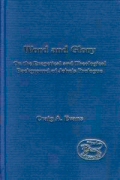
Word and Glory challenges recent claims that Gnosticism, especially as expressed in the Nag Hammadi tractate Trimorphic Protennoia, is the most natural and illuminating background for understanding the Prologue of the Fourth Gospel. Scriptural allusions and interpretive traditions suggest that Jewish wisdom tradition, mediated by the synagogue of the Diaspora, lies behind the Prologue and the Fourth Gospel as a whole, not some form of late first-century Gnosticism.
Several features of the Fourth Gospel reflect the synagogue and nascent Christianity's struggle to advance and defend its beliefs about Jesus who, as God's son and Agent, was understood as the embodiment of the Divine Word. All of the ingredients that make up Johannine Christology derive from dominical tradition, refracted through the lens of Jewish interpretive traditions. There is no compelling evidence that this Christology derived from or was influenced by Gnostic mythology. Word and Glory also develops and tests criteria for assessing the relative value of post-New Testament sources for the interpretation of New Testament documents.
Craig A. Evans (Ph.D., Claremont) is Payzant Distinguished Professor of New Testament, Acadia Divinity College Wolfville, Nova Scotia, Canada.
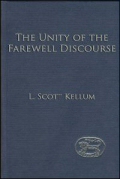
The volume is, primarily, a linguistic investigation into the possibility that the Johannine farewell discourse is the product of multiple hands. L. Scott Kellum uses the latest linguistic tools and applies them to the very old question of unity. In doing so, he accesses a large portion of Continental scholarship that is currently unavailable to English speakers. He concludes, on linguistic and literary grounds, that John 13:31–16:33 (the so-called farewell discourse) was written by one man at, essentially, one time.
L. Scott Kellum is currently an Assistant Professor of New Testament and Greek at Southeastern Baptist Theological Seminary at Wake Forest, North Carolina.
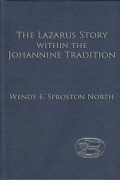
This historical-critical study of the Gospel of John and the First Epistle of John challenges the commonly held view that the first Johannine epistle is related to the Gospel. Sproston argues that the two writings are indirectly related through a common Johannine tradition. A comparison of the two therefore allows traditional material in the evangelist's work to be isolated, enhancing our understanding of the creative processes involved in its composition. The account of the raising of Lazarus is rigorously analyzed as a test case for this kind of analysis.
Wendy E. Sproston North formerly taught in the Department of Theology, University of Hull.
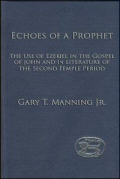
Echoes of a Prophet: The Use of Ezekiel in the Gospel of John and in Literature of the Second Temple Period
- Author: Gary T. Manning, Jr.
- Vol. 270 in the Journal for the Study of the New Testament Supplement series
- Publisher: T & T Clark
- Publication Date: 2004
- Pages: 256
Echoes of a Prophet examines intertextual connections to Ezekiel found in John and in Second Temple literature. The Dead Sea Scrolls contain many allusions to a number of Ezekiel's oracles, while other Second Temple works refer to only a few of Ezekiel's oracles, and those only rarely. In each case, Manning examines the evidence for the presence of the allusions, studies the implied interpretational methods, and comments on the function of the allusion in advancing the author’s ideas.
Manning also analyzes John’s allusions to Ezekiel: the good shepherd, the vine, the opened heavens, imagery from the “dry bones” vision, and water symbolism. He observes that John has a few unique tendencies: he alludes to all five of Ezekiel's “oracles of hope” and primarily uses that imagery to describe the giving of the Holy Spirit and new life through Jesus.
Gary T. Manning, Jr. is an Assistant Professor of New Testament and Director of the Graduate School in Honolulu, Hawaii.
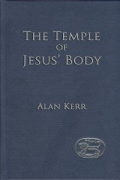
This book is a study of the Johannine Christian response to the fall of the Jerusalem Temple in 70 C.E.. A crucial text in this investigation is Jn 2.13-22 and its context, which provide a lens through which other texts in John are viewed. Kerr's examination of the Temple festivals of Passover, Tabernacles, Dedication suggests that Jesus fulfils and replaces these, while in the case of the Sabbath he effects a transformation. The overall conclusion is that the Johannine Jesus replaces and fulfils the Jerusalem Temple.
Alan Kerr received his PhD from University of Otago and is currently living in Dunedin, New Zealand.
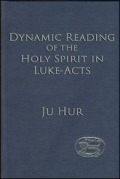
With 17 references to the divine πνε?μα in Luke’s gospel and 52 in Acts, it is no wonder that Luke is designated as the “enthusiast in/for the Spirit” or that the Acts of the Apostles is called “the Acts of the Holy Spirit.” The Holy Spirit has also been one of the most constantly debated subjects among the many issues concerning Luke and/or Acts.
This study will re-visit the topic of the Holy Spirit in Luke-Acts through a new perspective. The first portion of this volume discusses three contemporary understandings of Lukan pneumatology; that of J. D. G. Dunn, R. P. Menzies and M. M. B. Turner. These reflect three different positions in regard to this subject. The next portion sets out the author’s methodology and procedure for A Dynamic Reading of the Holy Spirit in Luke-Acts.
Ju Hur is Lecturer in New Testament Studies at Asia United Theological University in Seoul, South Korea.
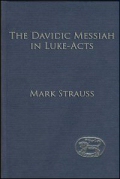
The nature of Lukan Christology has been much debated in recent years, with scholars claiming the pre-eminence of such categories as Lord, Prophet, Christ, or Isaianic Servant. In the present work the author examines one major theme within Luke's Christology, that of the coming king from the line of David. A study of the Lukan birth narrative and the speeches in Acts reveals that Luke shows a strong interest in this royal-messianic theme, introducing it into passages which are introductory and programmatic for his Christology as a sermon, portraying Jesus in strongly prophetic terms.
The author seeks a synthesis of these seemingly conflicting royal and prophetic portraits in Luke's interpretation of the Old Testament book of Isaiah. When Isaiah is read as a unity, the eschatological deliverer is at the same time Davidic king (Isa. 9.11), suffering servant of Yahweh (Isa. 42-53), and prophet herald of salvation (Isa. 61), leading God's people on an eschatological new exodus. On the basis of this synthesis the Christology of Luke-Acts is seen to be both consistent and unified, forming an integral part of Luke's wider purpose in his two-volume work.
Dr. Mark Strauss teaches at Bethel Theological Seminary in San Diego, California.
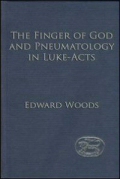
Luke's interest in the Holy Spirit is well-known, so when instead of having Jesus say, “ If I cast out devils by the Spirit of God...” as Matthew has it, he writes, “If I by the finger of God...” Luke poses a question that has puzzled many commentators since. Woods argues that in fact the phrase “finger of God” holds the key to understanding the role of the Spirit in Luke-Acts. Taking into account the background to the phrase, Luke's larger theological interests within the Beelzebub section itself, the Travel Narrative, and the program of Luke-Acts as a whole, he offers a new solution to an old exegetical question.
Edward Woods is Lecturer in Old Testament, Bible College of Victoria, Lilydale, Victoria, Australia.
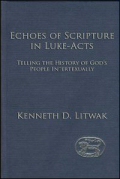
Litwak challenges previous studies of the use of the Old Testament in Luke-Acts as inadequate. In contrast to previous studies that consider only quotations or obvious allusions, he examines intertextual echoes of the Old Testament at strategic points in Luke-Acts, as well as quotations and allusions and echoed traditions. Thus, this study's database is larger. Previous studies generally argue that Luke's use of the Scriptures is in the service of Christology. This leads to the exclusion of scriptural citations, such as those of the temptation (Luke 4.1-13) which have different emphases. Litwak views ecclesiology as the overall purpose behind Luke's use of the Old Testament, but he does not skip or avoid intertextual references that may lie outside an ecclesiological function. Whilst other studies contend that Luke uses the Old Testament according to a promise-fulfillment/proof-form-prophecy hermeneutic, Litwak argues that this fails to account for many of the intertextual references. Other studies often subsume all of Luke's use of the Scriptures of Israel under one theme, such as the 'New Exodus', but this study does not require that every intertextual echo maps to a specific theme. Rather, the many intertextual references in strategic texts at the beginning, middle and end of Luke-Acts, and Luke's use of the texts, are allowed to dictate the 'themes' to which they relate.
Kenneth D. Litwak completed his Ph.D. at Trinity College, University of Bristol.
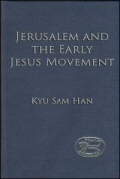
This book deals with the place of the source document Q and its compilers within late Second Temple Judaism, with special attention to Q's relationship to the Herodian Temple. The investigation of this perspective is fraught with problems because the passages that are associated with the Temple in Q do not speak with the same voice, raising the question of how to reconcile the seemingly positive view with the rather more hostile views.
Using a comparative approach, Han analyses the essential differences in the two types of positions, and concludes that the negative attitude is original, while the positive position is due to a later redaction after the First Revolt and the destruction of the Temple.
Kyu Sam Han is Associate Professor, International Theological Seminary, Los Angeles, California, USA.
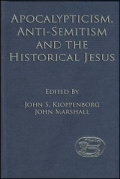
Virtually all scholars agree that apocalypticism and millenarianism formed at least part of the matrix of the culture in first-century Jewish Palestine, but there is a sharp disagreement concerning the extent to which Jesus shared apocalyptic and millenarian beliefs. Although there has been a great deal written defending or opposing an 'apocalyptic Jesus', almost nothing has been said on the questions of what, from the standpoint of modern historiography of Jesus, is at stake in the issue of whether or not he was an apocalypticist or a millenarian prophet, and what is at stake in arguing that his alleged apocalypticism is a central and defining characteristic, rather than an incidental feature. Much has been said on the kind of Jew Jesus was, but almost nothing is said on why the category of Judaism has become so central to historical Jesus debates.
These questions have less to do with the quantity and character of the available ancient evidence than they do with the ways in which the modern critic assembles evidence into a coherent picture, and the ideological and theological subtexts of historical Jesus scholarship. Scholars of Christian origins have been rather slow to inquire into the ideological location of their own work as scholars, but it is this question that is crucial in achieving a critical self-awareness of the larger entailments of historical scholarship on Jesus and the early Jesus movement. This volume begins the inquiry into the ideological location of modern historical Jesus scholarship.
John S. Kloppenborg is Professor of Religion at the University of Toronto, Canada. He is well-known for his ground-breaking work The Sayings Gospel Q. His most recent publication is Excavating Q: The History and Setting of the Sayings Gospel. He is currently writing a commentary on James for the Hermeneia series.
John Marshall is Assistant Professor of Religion at the University of Toronto.

Scholarly literature on Jesus has often attempted to relate his miracles to their Jewish context, but that context has not been surveyed in its own right. This volume fills that gap by examining both the ideas on miracle in Second Temple literature (including Josephus, Philo, the Dead Sea Scrolls, Apocrypha and Pseudepigrapha) and the evidence for contemporary Jewish miracle workers. The penultimate chapter explores insights from cultural anthropology to round out the picture obtained from the literary evidence, and the study concludes that Jesus is distinctive as a miracle-worker in his Jewish context while nevertheless fitting into it.
Eric Eve is a Senior Research Fellow and Tutor in Theology at Harris Manchester College, Oxford.
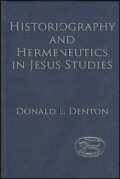
Historiography and Hermeneutics in Jesus Studies: An Examination of the Work of John Dominic Crossan and Ben F. Meyer
- Author: Donald L. Denton
- Vol. 262 in the Journal for the Study of the New Testament Supplement series
- Publisher: T & T Clark
- Publication Date: 2004
- Pages: 248
This work identifies two distinct methodological approaches in Jesus studies, as represented by the work of two prominent historical Jesus scholars, Dominic Crossan and Ben Meyer. Crossan’s work is the apotheosis of a venerable approach centered on “tradition criticism.” Meyer offered a critique of this approach in the form of a historiographic “holism.” This work brings Meyer’s proposals to light in a sharp comparison with the historiographic assumptions he criticized. It goes beyond Meyer, recognizing the full significance of narrativity in historical method.
Donald L. Denton is Senior Lecturer in Biblical Studies at Westmont College, California.